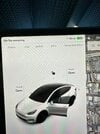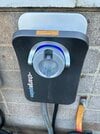Just because an EVSE is rated for 40a doesn't mean it will be wired for 40a or configured for it. Are there multiple chargers? It could be the parking lot only has a limited number of amps and it has to divide them up over the different EVSEs. Some smarter EVSEs can network and share the power (so if the others are not plugged in, you get all 40, but you get less if you have to share.) This doesn't look like they have that.
16 amps at 240 volts is quite a lot though. The average car drives under 40 miles/day, That should recharge on a 16a station in less than 3 hours on average. Some days will take more, some less. Unless you have a long commute. You may want to use level 1 at home on the weekends to cover that situation. It is perfectly fine not to charge all the way to 80% every day. If you don't have a long drive planned, and you came in very low, you may only get to 60% but that could be just fine. If not, there are superchargers, but the need for that is rare.




